There’s no denying the facts: The construction industry would be an entirely different ballgame had drywall not been invented. The biggest benefits of this readily available material, say builders, are:
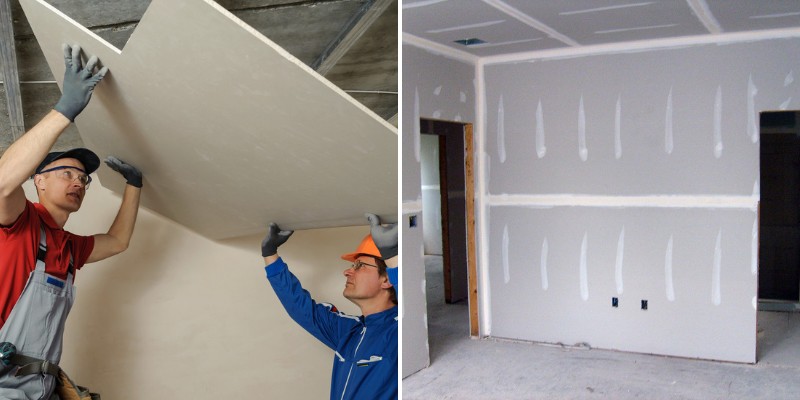
- -Affordability — you can choose from myriad grades that come with a wide variety of flexible price points.
- -Insulating properties; drywall adds a layer of protection between rooms and between rooms and the outside.
- -Drywall helps keep extreme weather outside.
- -Drywall can dampen sound and can help make your home safer, healthier, and cleaner.
- –Some types of drywall come with impressive fire resistance ratings.
- -Drywall insulates interiors from mold growths that cling to exterior materials.
Add to this list a homeowner’s ability to repair most drywall damage with a few tools, spackling and sandpaper plus the endless number of finishing options that are only possible over a drywall base and you understand how important a role drywall plays in the construction of any building these days.
In this article we have gathered some of the most popular and useful questions that people ask about drywalls and offering answers to them, so let’s get started:
How much do drywall sheets weigh? (½-inch and 5/8-inch)?
On average, you can expect ½-inch drywall sheets meant for residential interior use to weigh approximately 1.6-pounds per square foot totaling around 51.2-pounds per average sheet (4×8 size)
Stipulate 5/8-inch-thick drywall sheets and the weight is likely to be around 70 pounds per panel.
Purchase drywall panels that are fabricated with moisture-resistance materials or oversize sheets (e.g., 4- x 12-feet) and you might have to heft 125-pound panels to finish the job.
How much does a 4×8 sheet of drywall cost?
According to HomeAdvisor, the average cost of a drywall 4′ x 8′ panel of this size is going to range between $12 and $20 per panel sheet.
Why the wide range? The thicker the panel or the more complex the materials used to manufacture some sheets (e.g., those that offer soundproofing) could easily bring the total price to $60 each, so if you’re looking for a ballpark for a 200-square-foot room, you could spend up to $500 to for the materials needed to do the job.
How much does it cost to drywall a 2000 square foot house?
Based on the estimate of $500 per 200-square feet of coverage, you may wish to budget $5,000 to complete a job that covers this much area. This is only the drywall cost (not including labor).
How much would it cost to drywall a 1500 square foot house?
You’ll spend less for a drywall project that covers 1500 square feet; Approximately $3500-$3700 would be a good ballpark guess for the drywall material cost.
What Thickness Drywall for Walls?
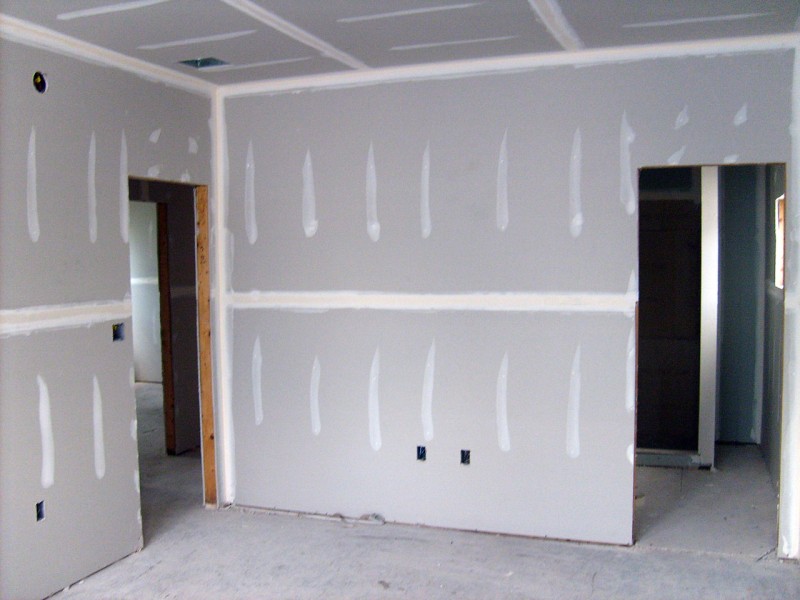
According to the DIY Network, the two most commonly sold drywall sections measure either 3/8-inch or ½-inch, but experts note that thicker panels are necessary in two instances: if nails or screws are to be installed far apart and if the construction happens to be designed so there are large gaps between studs or joists.
The most common drywall thickness for interior walls is 1/2 inch.
For walls that require fire-resistant rating or for ceilings, drywall panels should be 5/8 inch.
Is Drywall Flammable?
Drywall is “relatively fireproof.” Sheets made with glass fibers can increase fire resistance and more companies are incorporating them when making the gypsum.
Use 5/8th-inch Type X panels which meet American Society for Testing and Materials (ASTM) guidelines, and you may prolong the spread of fire for at least 30 minutes.
Similarly treated ½-drywall panels can resist fire for up to 45 minutes. There are no guarantees that fire won’t spread, but the right drywall can slow it down, buying you time to escape and for firefighters to begin their efforts to extinguish the blaze.
Is Drywall Dust Toxic?
It can be if you don’t take precautions, say folks at the Centers for Disease Control (CDC).
When sanding panels, dust, and respirable silica (silica, talc, calcite, gypsum, and mica) are disbursed.
Workers not wearing protective gear could suffer throat and airway irrigation issues, cough and exhibit symptoms reminiscent of asthma.
Workers who ignore these warnings increase their chances of developing silicosis or lung cancer.
Contractors using lightweight sanding systems now on the market control dust disbursal.
A recent NIOSH Health Hazard Evaluation (HHE) study concluded that simply by changing from hand-sanding to pole-sanding, respiratory risks are lessened.
Should drywall be vertical or horizontal?
Both. Vertically hung drywall is recommended for commercial jobs to meet fire code requirements, but on residential jobs, most installations are horizontal.
“For walls 9 feet high or shorter, hanging the drywall horizontally has a number of benefits,” say ProBuilder.com experts, including fewer seams and a more uniform looking finish.
That stated, drywall hung vertically tends to be structurally stronger than sheets that are mounted horizontally.
How to patch a hole in drywall?
The materials, tools, and techniques you use to do the repair depend upon the size of the drywall hole you’re looking to fill. These tips will help you decide:
- Tiny holes require a putty knife to apply either spackling or wall joint compound. Once dry, sand lightly.
- Small holes (½-inch to 1½-inches) call for the application of adhesive-backed mesh followed by spackling. Once dry, sand and paint or add a second spackle layer, repeating the drying and sanding steps.
- Medium holes (1½-inch to 6 inches) are best fixed with a galvanized-metal patch. Peel off the backing, center the patch and apply up to 3 coats of wall joint compound, drying and sanding between applications.
- Large holes (6 inches+) require more steps. This YouTube video shows you how to accomplish this task correctly:
What is the best way to cut drywall?
Expert Lee Wallender has taken the process of cutting drywall down to around 30 seconds for The Spruce website, so follow his easy steps to do the job.
Use a metal ruler and a utility knife to score the drywall panel along the line you intend to cut.
Repeat the process if two cuts are required.
Stand the scored panel on end and break the sheet firmly at the line using your knee. If the paper clinging to the back side of the drywall sheet remains attached, use the utility knife to take care of it.
What grit sandpaper is best to use on drywall?
Experts at Norton Abrasives recommend using one of three types:
- 80 or 100 grit sandpaper,
- 120 grit sanding screen or use a medium grit sanding sponge.
- For large areas, use a rubber sanding block to do the job because it will help support the sandpaper and also make sure the sanding surface stays completely flat while sanding.
How to fix a crack in drywall that keeps coming back?
With changing seasons, weather can “re-open” repaired drywall cracks. To make sure the next application stays put, rake the old material out of the crack.
Next, apply the most flexible patching material on the market (it should be the consistency of yogurt).
Spread it in thin layers over the crack using a 6-inch joint-taping knife. This type of patch can’t be sanded, so smooth the surface and remove excess adroitly before painting.
How many coats of primer should be used on new drywall?
DIY guru Bob Vila claims to have the market cornered on this topic, calling his answer “the magic number” to which professionals should ascribe. His recommendations:
- As a general rule, “one to two coats of primer will suffice” when painting interior walls.
- You can probably get away with one coat if the wall is already white and you pick a top-of-the-line primer product.
- Select a tinted primer if you want to ensure that the color paint you use is more intense.
- Opt for two coats of primer if your drywall is unfinished or if the wall surface is plaster.
- Apply two coats of primer if you’re prepping a dark wall that is to be painted with a light color so you don’t risk the dark color “peeking” through.
- Don’t bother with primer if you’ve chosen a self-priming paint product.
How many screws should be used per sheet of drywall?
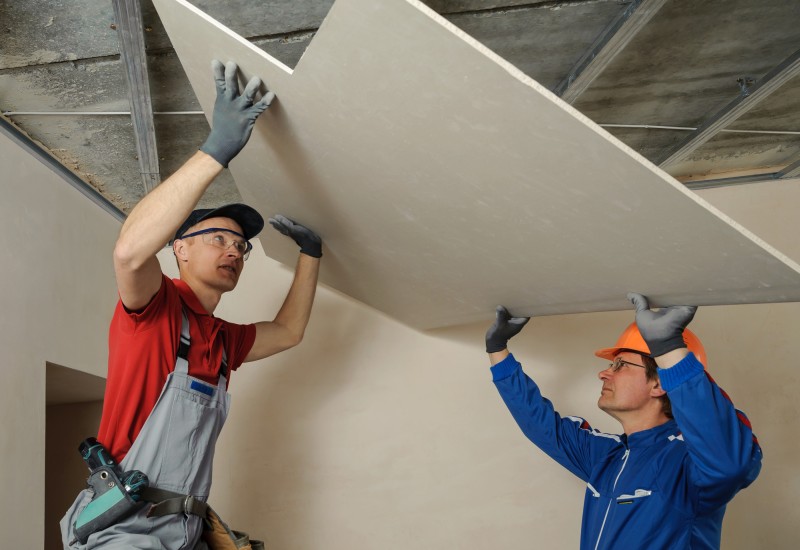
Want to get into an argument with other DIYers? The Spruce’s Lee Wallender says mention the topic of screw placement when attaching drywall panels and the debate could last hours.
Wallender writes that the magic number is “about 32 drywall screws per sheet of 4-foot by 8-foot drywall installed horizontally”.
This breaks out to 4 screws destined for the 5 middle studs and 6 on each of the two sides.
Not a math whiz? Here is Wallender’s example of how to grasp this calculation: If you’re drywalling a room that measures 320 square feet, 10 sheets of drywall will cover all your bases using 32 drywall screws for each section.
What size screws are best to use on drywall?
According to contractors writing blog posts for the Home Depot website, there are 4 types of drywall screws you’ll want to acquire because they all serve different purposes.
Coarse screws feature threads that secure sheets to studs, fine screws have smaller heads and are made to secure panels to metal studs, self-drilling screws work with metal studs or frames. Screw sizes depend upon the thickness of the drywall.
- If you’re installing ½-inch drywall, purchase 1-1/4 or 1-3/8-inch screws
- Working with 5/8-inch sheets? Choose 1-3/8-inch or 1-5/8-inch screws.
- If you want to double down on security and employ drywall nails as well, remember that drywall nails only penetrate wood, not metal studs.
Seven Innovations just for drywallers
For contractors who specialize in this work as well as do-it-yourselfers, the future of drywall could depend upon new products and innovations that hit the market to reduce the amount of physical stress and effort required to accomplish these projects.
The drywall industry has recently introduced the following 7 products, writes Hannah Belloli for Walls & Ceilings magazine, to help achieve that goal. They include:
- Finish Coat Trowels, manufactured by Italy’s Bianko ProFlex “helps workers achieve walls that will remain clear with no marks; the chromium coating allows a quicker application and an easier and faster cleaning of the blade once finished.”
- Electrical Box for Fire-coded Drywall introduced by ezBoxPRO. This tool “marks the location of electrical boxes on drywall and it also protects electrical boxes and wires,” helping to make the jobs of contractors easier and less expensive.
- The Warrior Flat Finishing Extension Handle weighs less than 3 pounds and extends from 38-to-60 inches, so with the press of a button, you can reap the benefits of this handle and no attachments are required to use it.
- An Auto-feed Driving System, introduced by Simpson Strong-Tie, is a “newly improved auto-feed screw driving system for attaching drywall” that comes “with a precise self-locking depth adjustment, ratcheting rotatable head (for clearance in space-restricted corners) and adapters that work with preferred screwdriver motors.”
- Also new to the market is a Drywall Washing System manufactured by Mudmaster. “The Washmaster Pro is a drywall tool washing system designed to have a small footprint while doing a big job” by washing, de-foaming and separating mud from drywall taping tools.
- BeroGrip Skimming Blades, available from Barnaby Tools & Equipment, “are the most versatile drywall finishing blades in the industry. Available in four sizes from 10 to 20 inches,” these blades offer superior ergonomic grips and they are made of INOX stainless steel, “ensuring ten times more contact area with the surface over traditional taping knives.”
- Advance Equipment’s skimming blades are designed to “Reduce jobsite fatigue from constantly bending and reaching down to switch tools while skimming and patching walls,” yet they function like two-handed smoothing blades. The blades are available in 10-, 12-, 14- and 16-inch lengths and are made in the U.S.A.
Can You Use A Staple Gun on Drywall
The simple answer is that you can use a staple gun on drywall. However, you really shouldn’t attempt to attach drywall to wood or metal stud framing with staples.
It is appropriate to attach corner beads with a staple gun. The gun should be one that is approved for this purpose.
The pressure needs to be calibrated so as not to crush the corners of the wallboard.
It is also fine to attach posters and similar items to drywall with staples. It is a good idea to ask your drywall supplier to recommend the best staple gun for use with drywall.
Which Mineral is the Major Component of Drywall
The primary mineral component of drywall is gypsum. Gypsum is a silicate mineral mainly composed of calcium carbonate.
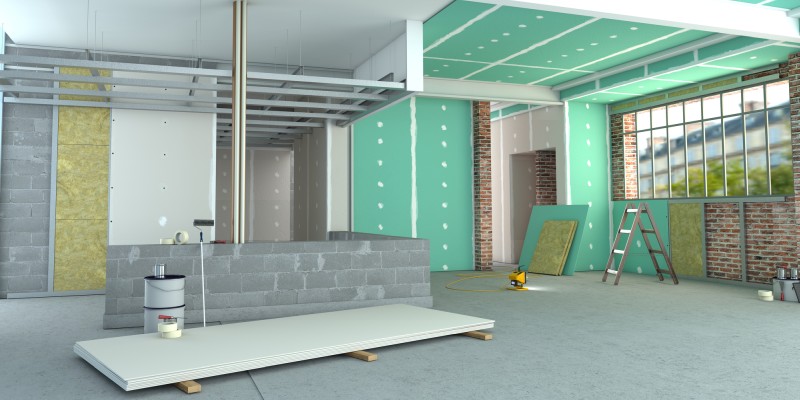
Calcium carbonate is a form of ground limestone. It is a fine pale-colored powder that can be molded into different shapes when combined with water.
This mineral is non-combustible which makes it ideal for fire resistance in construction.
Can Bats Eat Through Drywall
Most bats have a pronounced and strong set of teeth. These are used to bite down on hard-shelled insects that they consume or to puncture flesh if they are blood-feasting bats.
Bats are not normally attracted to wallboard and other hard construction materials as a meal, so they aren’t known for chewing through drywall.
Does Primer Cover Up Drywall Imperfections
Primer is a paint undercoating. It is applied to a variety of substrates to smooth the surface and hide minor imperfections.
Primer is a base coat that paint is applied to. It improves the adhesion of the paint to any surface.
You can’t rely on primer alone to cover up all imperfections, especially very noticeable divots or bubbles.
It is necessary to prep the drywall with compound before applying primer. Compound is a thin plaster-like material that is troweled over taped seams, screwheads, corner beads, and small surface damages.
You do need to allow the compound to dry thoroughly and be sanded smooth between each layer.
A high-quality primer is applied to the properly prepared wall prior to the finish coats of paint being rolled and brushed on.
Is Drywall Non-Porous
Drywall is in fact a porous material. Porous materials, such as gypsum drywall, can attract moisture in humid environments, such as bathrooms and kitchens.
When moisture penetrates drywall, mold spores can develop and multiply rapidly. Some drywall products have other ingredients in addition to gypsum, such as wood fibers, that mold can feed on and further proliferate.
Standing water can be especially damaging to drywall. It can cause the material to deteriorate quickly.
Areas of high humidity are best finished with either moisture-resistant tile backer board (green board) or glass fiber mesh board (cement board) rather than standard drywall.
These products are better suited for wet conditions and as a substrate for the application of tile.
Will Lowes Cut Drywall for You
Lowe’s can cut drywall purchased in their stores to the sizes specified by customers but it depends on the specific store. Some stores do this for you but others don’t.
There often isn’t a charge if this is a minimal order. Lowes will not be held responsible for incorrectly sized drywall if your dimensions are not correct.
Why would you want Lowes to cut your drywall? Many DIY home builders and repairers do not have a truck bed big enough to accommodate large sheets of drywall, so this is a reasonable request for easy transport.
Lowes does sell the appropriate tools for customers to cut their own drywall. Right before you checkout, let a sales clerk know that you want to have Lowes cut the drywall for you and they will explain the process.
You will likely have to purchase the full sheet of drywall first.
Can You Use a Table Saw to Cut Drywall
Cutting drywall with a table saw is possible, but not the recommended method. The saw needs to be outfitted with a thin, very sharp blade known as a kerf.
A kerf blade has more teeth than a standard blade used for cutting wood. This ensures that the delicate core material in the drywall doesn’t get damaged and crumble.
In addition to using the correct saw blade, it is important to set the height to the proper depth of the drywall. Honestly, the better method for cutting drywall is using a jab saw or drywall utility knife.
Can I Paint Drywall Without Plastering
Plastering, or applying drywall compound prior to priming and painting drywall, is a very important step.
You don’t need to skim coat the entire drywall surface with a plastering compound.
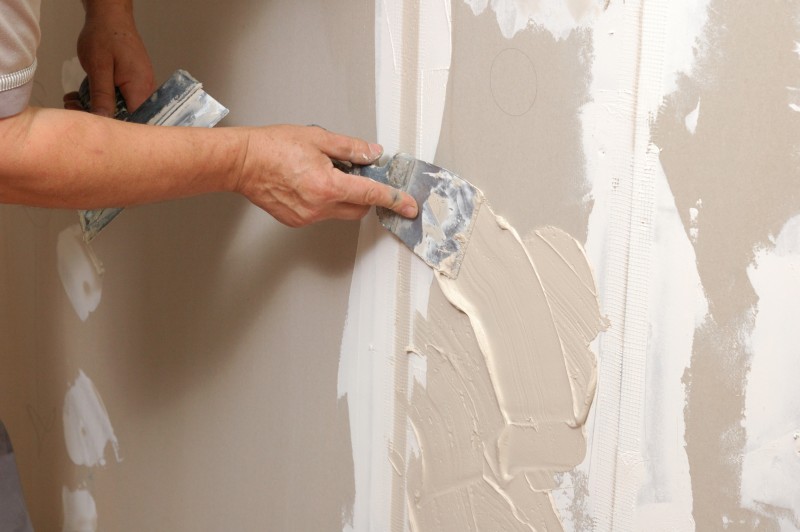
You must properly tape and compound the drywall joints, fastener heads, and corner beads before you prime and paint.
This step seals the joints and smooths the imperfections. As well, local building codes may require that drywall in areas of potential fire hazards be sealed to form a complete protective barrier to the substrate.
The bottom line is that plastering and sanding your drywall surface will result in a much more durable and attractive finish before painting.
Is Painted Drywall Porous
This is an interesting question. Drywall is porous by nature. Because of this, it can attract moisture and may develop mold.
Primer and paint can definitely help to deter that from happening. Though, it depends largely on the products you choose to coat the drywall with.
There are some finishes that are better able to seal and protect the drywall from the climate inside the home. These included oil-based primers and coatings, as well as mildew-resistant latex paints that are considered “washable”.
Be mindful that water infiltration from the building exterior can potentially damage the unpainted surface of the drywall where it is attached to the framing.
How Much Does a 4×12 Sheet of Drywall Weigh
Drywall is considered a lightweight construction material. However, it is still heavy enough that you might need an extra set of hands to lift and hang the boards.
The rule of thumb for a 1/2-inch thick sheet of drywall is 1.6 pounds of weight per square foot of surface area.
Therefore, a 4-foot x 12-foot sheet of drywall would weigh 76.8 pounds.
If you are using 5/8-inch thick drywall, you will need to consider that it will weigh 2.31-pounds per square foot or typically 110.88 pounds per sheet.
Can Home Depot Cut Drywall
As of 2022, Home Depot announced that it will no longer cut drywall for customers.
A new store policy states that employees can only use their power tools to cut wood for customers.
Because of this, Home Depot can’t guarantee that a store worker will be able to accurately cut drywall by hand, which could result in a cut sheet of drywall not fitting exactly as it should once it has arrived on the job site.
Customers can go to the Home Depot website and watch a video on how to properly cut drywall or use the “Home Services” option to find a local professional to help them with drywall cutting.
Is Shiplap Cheaper than Drywall
Shiplap is thin wood boards with two opposing rabbet joints or notches cut on the edges, designed to overlap and form a tight seal over wall framing.
Drywall is a gypsum material that is sandwiched between 2 sheets of specialty paper board. Drywall sheets are definitely cheaper than shiplap per square foot to purchase.
However, the installation of shiplap is usually less expensive than the drywall installation process when you take into consideration the labor and materials for compounding, sanding, and cleaning the dust associated with sanding.
Shiplap is definitely a product that a DIYer skilled with using a table saw can install, saving the cost of hiring a professional.
Can You Burn Drywall
Drywall is naturally fire-resistant due to the characteristics of the gypsum filler material.
Gypsum minerals are naturally flame-resistant and have a high melting point.
Drywall won’t damage until the temperature reaches 176°F. Alternatively, 5/8-inch thick, Type-X drywall won’t damage until the temperature reaches 451°F.
This type of drywall assembly can afford you up to 1 hour of fire protection, whereas a standard drywall assembly will typically offer 30 minutes of protection.
Type-X would be recommended when separating an attached garage from a home.
Local fire codes determine what types of drywall must be used for a variety of situations. It should be noted that it is not recommended that you try to burn drywall as a method for disposing of it.
What Side of the Drywall Faces Out
Drywall generally has 2 sides or faces. One side will be tan in color and the other will be either white/gray, green, or blue, depending on the application.
The tan face should always be up against the framing while the tinted side should be facing toward you while installing it.
If the tan side faces out, the finished surface will have imperfections and appear uneven.
What Size Screws for 5/8 Drywall
When installing drywall, you want to make sure you use the correct fasteners that are long enough to extend through the drywall and into the framing for secure attachment that will last a long time.
While there are some builders who prefer to use nails to hang drywall, this is not recommended.
If need be, you can secure the corners and centers of the boards with nails so that they stay in place while you use the appropriate screws to complete the installation.
For 5/8-inch drywall, you will want screws that are 1-3/8 to 1-5/8-inches in length.
Choose W-Type (course drywall screws) for wood framing and S-Type (fine drywall screws) for metal studs.
Be sure to slightly countersink the screw heads so that they can be well concealed with tape and compound.
Can You Put Shiplap Over Drywall
It is very easy to attach shiplap directly to wall studs because you can visually identify where the studs are.
In order to install shiplap over drywall, you will need the help of a stud finder. Most professionals recommend gluing the boards to the drywall prior to nailing them to the studs.
One thing to consider when placing shiplap over existing drywall is that the base, crown, window, and door trim might all have to be removed and replaced.
It can go on after the shiplap is installed to accommodate the increased depth of the wall. One of the benefits of placing shiplap over drywall is the added insulation value of the wall.
Can You Put Tile Directly on Drywall
This is a question that is often debated. It is possible to install tile over standard drywall in areas that are not subjected to high humidity or water.
Yet, the paper layer on standard drywall is not specifically designed to carry the moisture and weight of either thin-set mortar, mastic, or tile.
Tile backer boards, such as green board and cement board, are specifically designed to accept a tile finish.
Moisture-resistant green board is ideal for kitchen backsplashes and bathroom walls and ceilings.
Cement and glass fiber drywall sheets are specifically designed to be a base for tile in wet areas, such as showers and steam rooms.
If possible, use green board in place of standard gypsum wallboard in areas of low humidity for best results.
How Long Does Drywall Last
Assuming there is no damage to the walls and ceilings, drywall has been shown to last for about 70 years, maybe longer.
The reason for that number is that prior to the 1950s, many homes were constructed with walls finished in lath and plaster.
Moisture from plumbing and roof leaks or flooding will definitely reduce the lifespan of drywall that has sustained this kind of water damage.
Other elements that can significantly damage drywall include termites and rodents chewing on the paper layer and impact from hard objects causing the gypsum layer to crumble.
In an ideal environment free of moisture, mold, insects, rodents, and normal wear and tear, drywall can last decades. Keep in mind that small damaged areas of drywall are repairable.
What Happens if Drywall Gets Wet
Wet drywall is not a good thing. This can happen from floods, leaks, and humidity in the environment.
A small leak or an accidental splash of water isn’t the end of the world if attended to immediately.
You can dry off the water with towels, open windows, and place a fan on the affected area.
Extended exposure to water or humidity is less easy to address. Standing water can saturate the drywall and cause the gypsum to completely deteriorate or can promote the growth of mold.
Mold is a health hazard and must be remediated. What that means is that the damaged areas of drywall will need to be removed, the wall cavity dried out over time, and the drywall replaced.
There really is no way around this. There are professionals who can safely clean up water and mold damage.
What is Sag-Resistant Drywall
Sag-resistant drywall is generally 1/2-inch thick and lighter in weight than 5/8-inch thick boards.
Many of the products labeled sag-resistant have tapered edges with paper wrapped around the edges to protect the core of the drywall.
The boards contain a dense core that is enhanced with glass fibers. This type of drywall is often used for ceilings that may receive a heavy textured finish.
When shopping for this type of wallboard, make sure it is specifically identified as sag-resistant.
Resources
https://www.maramani.com/blogs/home-design-ideas/5-awesome-benefits-of-using-drywall
https://homeimprovement.lovetoknow.com/How_Much_Does_a_Sheet_of_Drywall_Weigh
https://www.homeadvisor.com/cost/walls-and-ceilings/sheetrock-drywall-prices/
https://www.diynetwork.com/how-to/rooms-and-spaces/walls-and-ceilings/all-about-the-different-types-of-drywall
https://www.angi.com/articles/drywall-fire-resistant.htm
https://www.cdc.gov/niosh/docs/99-113/default.html
https://www.probuilder.com/blog/details-matter-proper-direction-hang-drywall
https://www.thisoldhouse.com/walls/21015080/how-to-fix-a-hole-in-the-wall
https://www.thespruce.com/easy-way-to-cut-big-drywall-1821492
https://www.nortonabrasives.com/en-us/resources/expertise/drywall-repair
https://www.popularmechanics.com/home/interior-projects/how-to/a18077/how-to-fix-drywall-cracks-for-good/
https://www.bobvila.com/articles/how-many-coats-of-primer/
https://www.thespruce.com/drywall-screw-spacing-guide-4125925
https://www.wconline.com/articles/93119-drywall-innovations
Related Posts
- Comparison of Shiplap vs “Tongue and Groove” vs Beadboard Wall Paneling
- Comparison of Manufactured vs Modular Homes with Pros/Cons
- 10 Different Types of Glass for Home Windows (With Pros and Cons)
- Here Are The Main Pros and Cons of a Barndominium House
- Main Advantages and Disadvantages of Vaulted Ceilings for Homes
- Top 9 Drywall Alternatives for Your Home Ceiling (With Photos)
Leave a Reply